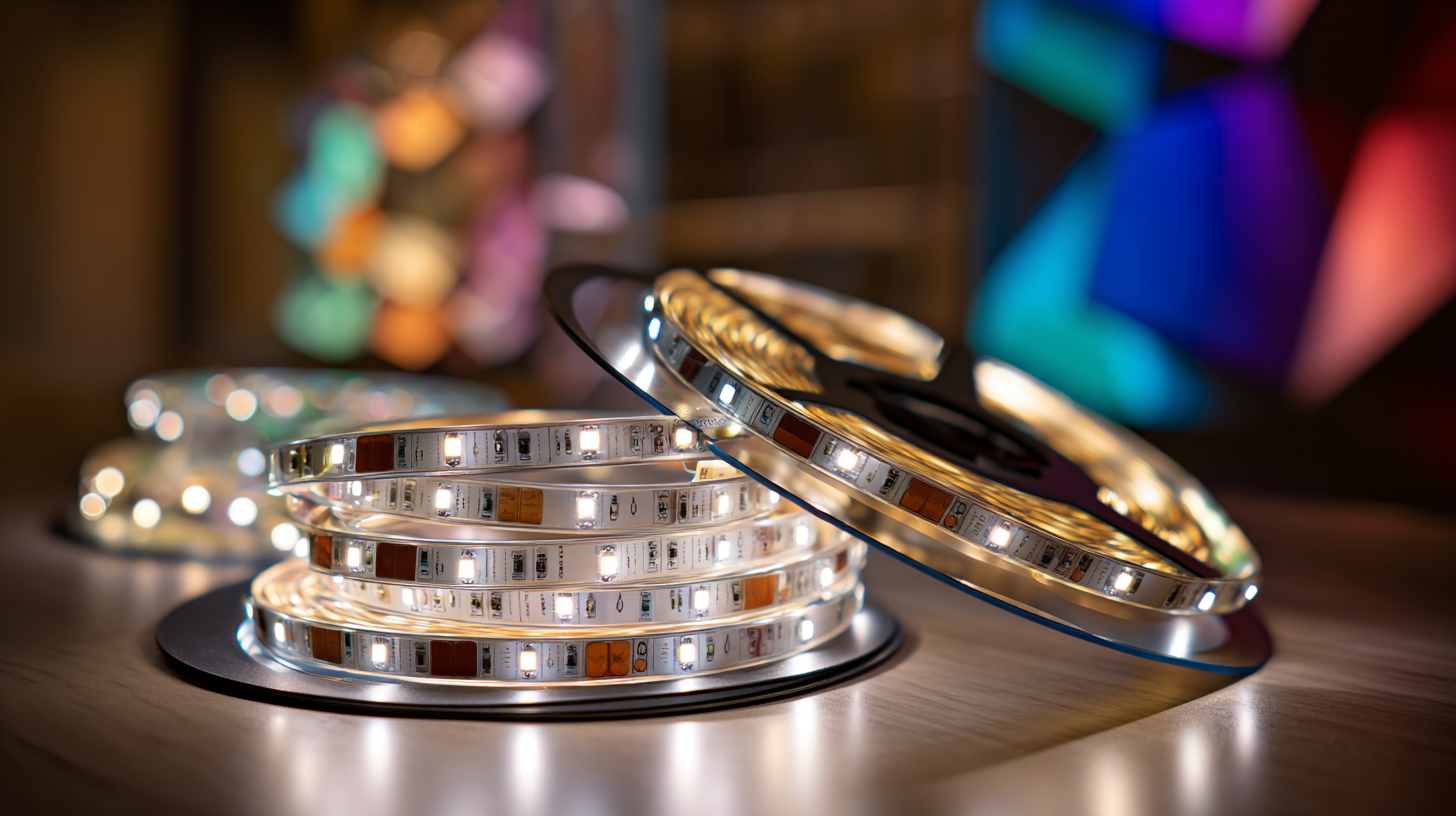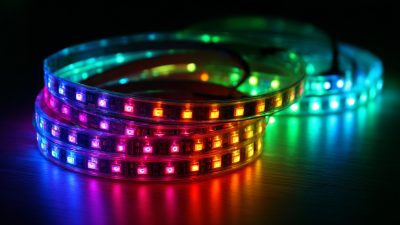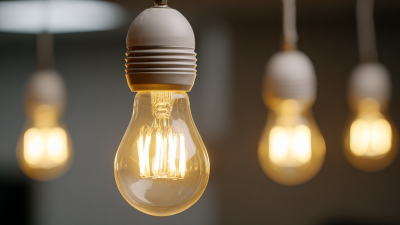

As the demand for sustainable and energy-efficient lighting solutions continues to rise, many homeowners and interior designers are turning to innovative options like LED tape lights. According to a report by the Department of Energy, LED lights consume up to 80% less energy compared to traditional incandescent bulbs, making them an eco-friendly choice for modern interiors.
 LED tape light, in particular, offers versatile applications, allowing for creative accent lighting that enhances ambiance while significantly reducing electricity costs. With the growing focus on reducing carbon footprints, the shift towards LED tape lights is not just a trend but a necessary adaptation for energy-conscious consumers.
This guide will explore the transformative impact of LED tape lights in interior design, showcasing their efficiency, aesthetic appeal, and the long-term benefits of integrating them into your space.
LED tape light, in particular, offers versatile applications, allowing for creative accent lighting that enhances ambiance while significantly reducing electricity costs. With the growing focus on reducing carbon footprints, the shift towards LED tape lights is not just a trend but a necessary adaptation for energy-conscious consumers.
This guide will explore the transformative impact of LED tape lights in interior design, showcasing their efficiency, aesthetic appeal, and the long-term benefits of integrating them into your space.
 In recent years, LED tape lights have emerged as a popular choice in modern interior design, seamlessly blending aesthetics and functionality. According to a report from the U.S. Department of Energy, LED lighting technology is now responsible for approximately 75% of the total lighting market growth, underscoring its rising trend in interior applications. These versatile lighting strips not only provide a sleek and contemporary look but also offer significant energy savings, making them an attractive option for homeowners and designers alike.
In recent years, LED tape lights have emerged as a popular choice in modern interior design, seamlessly blending aesthetics and functionality. According to a report from the U.S. Department of Energy, LED lighting technology is now responsible for approximately 75% of the total lighting market growth, underscoring its rising trend in interior applications. These versatile lighting strips not only provide a sleek and contemporary look but also offer significant energy savings, making them an attractive option for homeowners and designers alike.
The advantages of LED tape lights extend beyond mere visual appeal; they are designed to enhance ambiance while significantly reducing energy consumption. Studies suggest that switching from traditional lighting sources to LED tape lights can lead to energy savings of up to 80%. This remarkable efficiency not only helps reduce carbon footprints but also translates to lower utility bills for consumers. As urban spaces evolve and sustainability becomes a priority in design, the growing incorporation of LED tape lights marks a transformative shift toward energy-efficient solutions in interior spaces, catering to both environmental concerns and modern aesthetics.
LED tape lights have emerged as a popular choice in contemporary interior design, especially when compared to traditional lighting solutions. One of the most significant advantages of LED tape lights is their energy efficiency; they consume up to 80% less electricity than incandescent or fluorescent lighting options. This reduction in energy use not only lowers utility bills but also contributes to a more sustainable living environment. Unlike traditional lights, which often rely on heat to produce illumination, LED lights emit minimal heat, translating to additional savings and an extended lifespan, considerably reducing the frequency and cost of replacements.
In terms of aesthetics, LED tape lights offer versatility that traditional lighting cannot match. They can be easily installed in various settings, from under cabinets to along ceilings, creating an inviting ambiance tailored to the homeowner's preferences. Moreover, with options for color temperature and dimming capabilities, LED tape lights cater to a range of moods and activities, enhancing both functionality and design. This flexibility, combined with substantial energy savings, positions LED tape lights as the superior choice for modern interiors, challenging the longstanding dominance of conventional lighting solutions.
| Lighting Solution | Average Energy Consumption (W) | Average Lifespan (hours) | Initial Cost (USD) | Annual Energy Cost (USD) | Energy Efficiency (%) |
|---|---|---|---|---|---|
| LED Tape Lights | 12 | 50,000 | 30 | 20 | 80 |
| Incandescent Bulbs | 60 | 1,000 | 2 | 90 | 15 |
| CFL Bulbs | 15 | 10,000 | 5 | 30 | 60 |
| Halogen Bulbs | 50 | 2,000 | 8 | 120 | 20 |
LED tape lights are revolutionizing modern interiors not just in aesthetics but also in energy efficiency. According to a study by the LED Lighting Facts program, these innovative lighting solutions consume up to 80% less energy compared to traditional incandescent bulbs. This significant reduction in energy consumption is primarily due to their advanced semiconductor technology, which allows them to produce more light while using less power.
Furthermore, research from the U.S. Department of Energy indicates that switching to LED lighting can save an average household over $200 per year on electricity bills. When installed strategically, LED tape lights can enhance ambiance while minimizing environmental impact. Additionally, they have a longer lifespan, lasting approximately 25,000 hours, compared to the average 1,000 hours for incandescent bulbs. This combination of lower energy usage and extended longevity makes LED tape lights a cost-effective choice for homeowners looking to upgrade their interiors without breaking the bank.
This bar chart illustrates the significant energy savings achieved by switching from traditional lighting to LED tape lights. Traditional lighting consumes an estimated 100 kWh per month, whereas LED tape lights only consume about 20 kWh, showcasing an impressive 80% reduction in energy consumption.
LED tape lights have become a transformative element in modern interior design, significantly impacting both ambiance and energy efficiency. Various case studies highlight their effectiveness in reshaping indoor spaces. For instance, in a high-end restaurant, the installation of LED tape lighting along the contours of the bar and dining areas not only enhanced the visual appeal but also created a warm, inviting atmosphere. This strategic use of lighting reduces reliance on traditional overhead fixtures, allowing for softer, more dynamic illumination that improves the overall dining experience.
In residential settings, homeowners have embraced LED tape lights for accentuating architectural features and enhancing mood. A recent transformation of a living room incorporated LED strips behind shelves and under furniture, generating a cozy yet modern vibe. The energy consumption reduction, approximated at 80%, aligns with sustainable living practices while providing customizable light options suited to both lively gatherings and quiet evenings. Through these real-world applications, it is clear that LED tape lights play a crucial role in not just aesthetics but also in promoting energy efficiency and comfort in interior environments.
As we look toward 2025, the future of energy-efficient lighting in modern interiors is brightening with innovative trends. Homeowners are increasingly gravitating towards LED tape lights, valued for their ability to significantly enhance ambiance while reducing energy consumption by up to 80%. This shift not only provides a sustainable alternative to traditional lighting but also allows for creative design possibilities that align with contemporary aesthetics.

Tips for Implementing Energy-Efficient Lighting:
In addition, the growing trend towards sustainability supports the use of renewable energy sources and energy-efficient appliances throughout homes, making them not only stylish but also eco-friendly. As we step into an era focused on wellness and minimal environmental impact, these lighting solutions are becoming essential in modern interior design.



